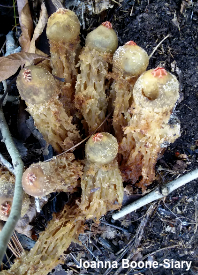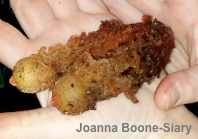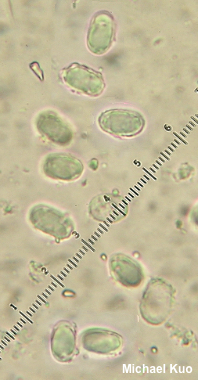| Major Groups > Puffballs > Calostoma microsporum |

|
Calostoma microsporum [ Basidiomycota > Boletales > Sclerodermataceae > Calostoma . . . ] by Michael Kuo This interesting species of Calostoma, like its brethren, features a round spore case perched atop what looks like a pedestal of half-digested spaghetti noodles braided together. Unlike Calostoma cinnabarinum, however, its spore case is not red and it is not initially covered with thick gelatinous goo. It is more similar to Calostoma lutescens, which also features a yellowish spore case, but Calostoma lutescens features a prominent "collar" under the spore case, and round, rather than ellipsoid, spores. Calostoma ravenelii is also very similar, and more commonly collected; it is a substantially smaller mushroom with a completely red "beak" at the top of the spore case (the beak of Calostoma microsporum is red between yellowish ridges) and, under the microscope, much larger spores. Castro-Mendoza and collaborators (1983) tried to reduce Calostoma microsporum to the status of a variety of Calostoma ravenelii, but did not correctly follow the rules of nomenclature (they didn't clearly cite the original species author's publication) and, thus, their "Calostoma ravenelii var. microsporum" is an invalid name—which is probably a good thing, because they shouldn't have made the attempt in the first place. Their reasoning was that, under a scanning electron microscope, the spores of the type collection of Calostoma microsporum were structurally similar to the spores of Calostoma ravenelii, despite being substantially smaller. However the authors overlooked other major differences: the notable overall size difference and the different beaks. After studying collections of both mushrooms I feel sure Calostoma microsporum should be maintained as a separate species unless DNA study indicates otherwise. Thanks to Joanna Boone-Siary for documenting, collecting, and preserving Calostoma microsporum for study; her collection is deposited in The Herbarium of Michael Kuo. Description: Ecology: Mycorrhizal with hardwoods; growing alone or gregariously; fall, or over winter in warm climates; eastern and southeastern United States, southward to Central America. The illustrated and described collection is from North Carolina. Fruiting Body: Spore case round or nearly so, 15–25 mm across, covered with a felty whitish coating that breaks up into granules as the spore case expands, surface underneath granules bald and dull yellowish, with a raised and ridged peristome ("beak") that is red between yellowish ridges; interior whitish and powdery at maturity; stem 3–8 cm long, 1–2.5 cm thick, composed of longitudinal, interwoven, pale brownish strands; odorless. Microscopic Features: Spores 9–12 x 5–7 µm; ellipsoid; occasionally smooth but mostly with sparse, irregular ornamentation/pitting; walls about 0.5 µm thick; hyaline to ochraceous in KOH. Capillitial threads 1–2 µm wide; smooth; hyaline or ochraceous; often with globular, refractive contents. REFERENCES: Atkinson, 1903. (Coker & Couch, 1928; Castro-Mendoza et al., 1983.) Herb. Kuo 12221802. This site contains no information about the edibility or toxicity of mushrooms. |
© MushroomExpert.Com |
|
Cite this page as: Kuo, M. (2019, November). Calostoma microsporum. Retrieved from the MushroomExpert.Com Web site: http://www.mushroomexpert.com/calostoma_ microsporum.html |


